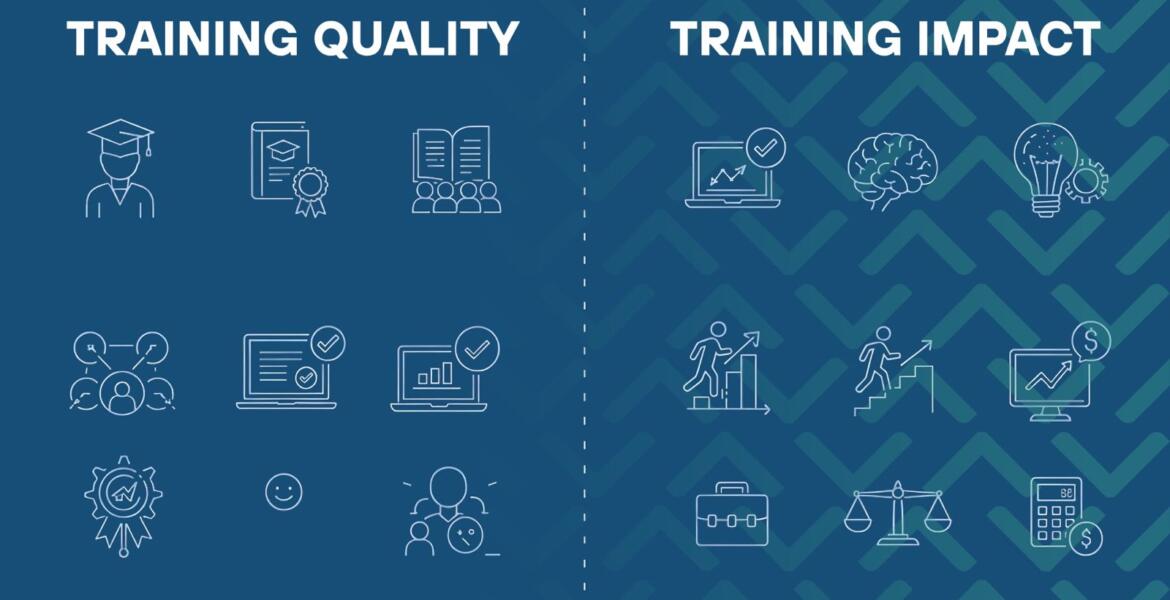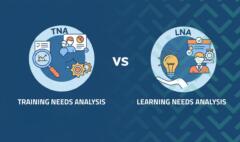Difference between Training Quality and Training Impact Measurement – How to distinguish between the two concepts and apply them effectively in training centers?

Difference between Training Quality and Training Impact Measurement – How to distinguish between the two concepts and apply them effectively in training centers?
Introduction
Why do we need to understand the difference between training quality and its impact?
In the fast paced world of training, it is not enough to organize an outstanding course or host an experienced trainer.
What matters more is asking yourself two essential questions:
Was this course of high quality? And did it truly impact the trainee’s performance?
Here lies the significant difference between Training Quality and Training Impact, two concepts often confused in the environment of training centers.
A course may be of high quality in terms of organization and content, but without any noticeable impact on the trainee’s behavior or performance.
On the other hand, positive results may appear on trainees without the course being ideal in terms of content or methods.
Understanding this difference is essential for any training center seeking excellence, whether in Saudi Arabia or elsewhere, because true success is not measured by the number of courses, but by their quality and sustainable impact on individuals and institutions.
What is meant by Training Quality?
Definition of Training Quality:
Training quality refers to the level of efficiency and professionalism in delivering the training program. It includes the quality of design, execution, learning materials, trainer performance, and the trainee’s experience during the course.
Key elements of training quality:
- Clarity of training objectives: Does the trainee know what they are learning? Are the objectives measurable?
- Trainer competence: Does the trainer possess professional experience and training skills?
- Content relevance: Is it aligned with job requirements, up to date, and modern?
- Delivery method: Is the training interactive and considers different learning styles?
- Training environment: Does the room, technology, or online platform support an effective learning experience?
- Trainee engagement: Does the trainee feel like a part of the training or just a passive recipient?
- Trainee satisfaction: Did the trainee leave the training satisfied with the overall experience?
Where is training quality measured?
It is usually measured during and immediately after the course through satisfaction surveys, content evaluation, trainer evaluation, and interaction feedback.
Why is it important?
Because training quality reflects the professionalism of the center and directly affects the reputation of the training provider and the continuity of cooperation with trainees or sponsoring entities.
What is the impact of training?
Training impact is the actual tangible result that appears on the trainee after the training, whether in their behavior, performance, productivity, or ability to make better decisions in the work environment.
Types of training impact:
- Cognitive impact: An increase in understanding and information.
- Behavioral impact: A change in how the trainee interacts with colleagues or clients.
- Practical/skills impact: The ability to perform a task or use a tool efficiently.
- Overall performance impact: An improvement in work indicators or productivity.
Who evaluates the impact?
- The trainee themselves (by comparing their performance before and after).
- The trainer or an external evaluator.
- The trainee’s manager or employing institution.
Importance of impact measurement:
Because it determines whether the training was worth the cost and time, and helps improve future programs based on real results.
When is training quality measured? And when is training impact measured?
Training quality measurement:
Occurs at 3 main stages:
Before the training:
- Reviewing the training material.
- Evaluating the trainer’s competence.
- Ensuring clear objectives.
During the training:
- Monitoring trainee engagement.
- Analyzing content delivery style.
- Evaluating the activities and their suitability.
Immediately after the training:
- Satisfaction survey.
- General evaluation of the training experience.
- Reviewing session recordings (in case of online training).
Training impact measurement:
Takes place in two main stages:
A few weeks after the training:
- Conducting a post test.
- Sending a survey to the trainee about practical application.
- Observing any new behavior or actual use of skills.
Two to six months after the training:
- Comprehensive evaluation of the employee’s or trainee’s performance.
- Interview with the direct manager.
- Comparison of performance indicators before and after the training.
Each stage provides a different type of data. Relying only on quality evaluation gives a limited impression. While combining both types offers a comprehensive view that helps in making strategic decisions.
The Relationship Between Training Quality and the Effectiveness of Training Outcomes
Training quality is not an end in itself, but rather the main means to ensure achieving tangible training impact. Without real quality in content, delivery method, and tools, it becomes difficult to achieve any long term effect.
How does quality affect outcomes?
- A course with poor content = a trainee who does not understand = no impact.
- A course with a weak trainer = an unengaged trainee = no application.
- An outdated course = invalid information = no value in outcomes.
On the other hand, training quality does not guarantee impact. For example, a course can be ideal, but the trainee does not apply what they learned, or the work environment does not support applying the skill. Therefore, we need integration between internal quality and external impact.
Tools for Measuring Training Quality in Training Centers
To accurately measure training quality, the following tools can be used:
- Trainee Satisfaction Surveys
- Distributed at the end of the course.
- Includes evaluation of the trainer, content, interaction, timing, technical support.
- Trainer Evaluation
- Can be self evaluation or by the course supervisor.
- Covers aspects such as clarity of explanation, time management, use of tools.
- Direct Observation
- Sending a supervisor to attend the training session and evaluate actual performance.
- Reviewing Training Materials
- Do they include real life examples?
- Is the language appropriate?
- Are they supported with modern media?
- Session Recordings Analysis (for e-training)
- Identifying strengths and weaknesses.
- Measuring level of interaction.
- Technical Indicators
- Attendance rate, number of completed tasks, interaction time, number of questions.
These tools are used during and after training and help make immediate decisions to improve quality.
Tools for Measuring Training Impact (Before – After – Later)
Training impact is not measured by feedback alone; accurate tools are needed to clarify improvement or change in performance.
- Pre Post Test
- To measure the difference in knowledge or skill level before and after training.
- Commonly used in technical or analytical courses.
- Performance Evaluation in the Workplace
- Measured by the supervisor or trainee’s manager.
- Based on new behavior, productivity, communication skills, etc.
- Trainee Interviews
- After one or two months, the trainee is asked: What has changed in your work because of the course?
- Long-Term Evaluation Surveys
- Sent to the trainee or beneficiary entity after 3 – 6 months.
- Comparison of KPIs (Key Performance Indicators)
- If the course is linked to a clear goal (e.g., reducing task execution time), numbers are compared before and after training.
Common Mistakes When Confusing Quality and Impact
- Relying on trainee satisfaction as a sufficient indicator: the trainee may like the training without actually gaining the skill.
- Ignoring the impact on the work environment: impact measurement should not be limited to the trainee but include the team and results.
- Believing an excellent trainer = guaranteed training impact: despite their importance, the trainer alone cannot create impact if suitable content or good assessment is missing.
How to Build an Integrated System for Evaluating Quality and Impact Together?
- Define clear and measurable objectives.
- Use dual tools: surveys + job performance evaluation.
- Make the evaluation continuous: before, during, and after training.
- Involve stakeholders: the trainee, the trainer, the manager, and the quality supervisor.
- Analyze the data deeply: link satisfaction evaluation with work results.
- Make decisions based on data: improve content, change the method, develop trainers.
The Role of Trainers and Employers in Improving Quality and Measuring Impact
Trainers:
- Provide objective feedback.
- Be prepared to apply new skills.
- Participate in post-training evaluations.
Employers:
- Provide a supportive environment for applying training.
- Monitor the performance of the trained employee.
- Participate in designing and evaluating training programs.
Using Technology to Track Training Quality and Impact
- LMS systems: To track attendance, tasks, evaluation scores.
- Artificial Intelligence: To analyze trainee interaction and provide recommendations.
- BI systems and performance reports: To link training with business indicators.
- Real time digital surveys: To measure trainee satisfaction during the session.
Technology facilitates data collection and analysis and helps in continuous improvement of both quality and impact.
Conclusion
How to Build a Training Center That Balances Quality and Impact?
True excellence for any training center is not only in the number of courses or trainer ratings, but in its ability to deliver a complete training experience that combines high quality with real impact.
To achieve this, you must:
- Design your programs professionally (quality).
- Follow up on their results after execution (impact).
- Involve the trainee and employer in all stages.
- Use modern tools and techniques.
- Improve based on real data, not assumptions.
Quality opens the door, but impact is what keeps the center in the lead.
Frequently Asked Questions (FAQs)
- What is the difference between trainee evaluation and training impact evaluation?
Trainee evaluation is measured immediately after training and reflects satisfaction, while impact evaluation is measured later and shows changes in performance or results. - How can a training center improve quality and increase impact?
By designing skill based curricula, training trainers, and using accurate and diverse evaluation tools. - Is trainer evaluation alone enough to measure training quality?
No, the content, interaction, tools, and trainee satisfaction must also be evaluated, not just the trainer. - Does every high quality training produce actual impact?
Not necessarily. If the trainee does not apply the skill or if it is not linked to the work context, the impact may not be achieved. - What are the recommendations for unifying impact measurement tools?
Building an internal model based on Kirkpatrick’s criteria, and training teams to regularly use evaluation tools.



